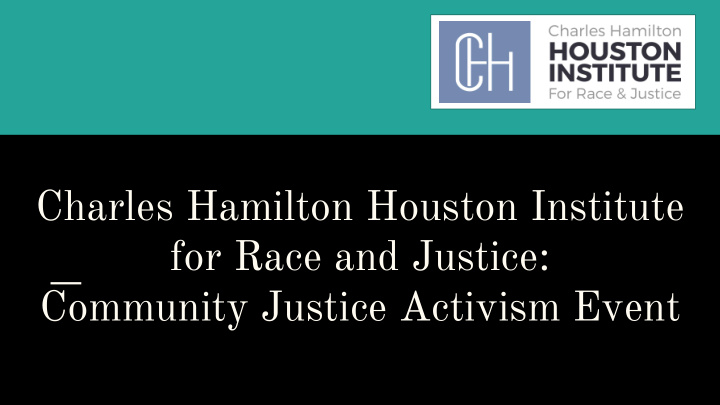



Charles Hamilton Houston Institute for Race and Justice: Community Justice Activism Event
Houston / Marshall Community Justice Plan The overall aim of this multi-year initiative is to galvanize and support a national movement to transform communities—overwhelmingly inhabited by people of color-- that have suffered from a deliberate public strategy of mass incarceration and disinvestment for more than 30 years. It is premised upon our belief that the entire country benefits in tangible ways— through improved public safety, economic prosperity, and productivity--from equitable policies that allow all individuals, regardless of where they live, to enjoy opportunities to thrive and fulfill their potential.
Houston / Marshall Community Justice Plan Dismantling mass incarceration is now achieving broad, bi-partisan support. But this goal, as worthy and important as it is, represents, in our opinion, only half of the necessary equation for comprehensive, systemic change. The other half involves redeveloping communities that have been devastated by hyper-policing, over-incarceration, and the enduring effects of decades of active neglect. It is this half of the equation—rebuilding—that will be the focus of the Houston Institute’s new initiative.
In helping rebuild communities of color, we plan to collaborate with activists around the nation. We will gather information on how activists are resolving issues communities of color are experiencing due to policies surrounding mass incarceration and divestment. This information will be placed on our website under “Community Justice Plan”
Community Justice This work will be fueled by our notion of “community justice,” which we define as the active participation of individuals living and working in communities hardest hit by crime and violence, and subject to recently discredited public policies. For too long, their voices have been shunted aside, ignored, or dismissed in these conversations, even as they are most directly affected by, and knowledgeable about, the conditions and needs within their communities.
Community Justice Event - Introduction Circle Everyone gathers and sits in part of a circle of chairs. The facilitator should start with ● opening statements to center the group. This can include reminders of the goal, a personal story related to the event, a poem, etc. This should also be a time to set ground rules (e.g. no speaking out of turn, be respectful, no phones, etc).
Community Circle Process - Introduction Circle The facilitator can then start with introductions - name ; school if ● student/organization is activists/neighborhood if resident ; what you’re looking to get from the process. Only the person with the talking piece should speak ●
Community Circle Process - Listening Circle Moderator will divide people into smaller groups - the goal is to have a diverse range of ● individuals in each of the smaller groups. We want a mix of students, activists, residents, older folks, younger folks, and people you haven’t worked with to build broad coalitions. Small groups should have a facilitator, someone recording, and a talking piece ●
Community Circle Process - Listening Circle Once everyone is in a small group, we begin the listening circle process - ● Residents of the area are a key component here ○ Residents with talking piece identify three (or more) issues they experience in their communities Facilitator for the small group will record each of the concerns ■ Before responding to any of the issues, make sure ALL residents speak about their ■ concerns ; at this point, include any online surveys that convey community input ○ Record it all!
Debrief Circle + “Open Mic” After grabbing food, we will gather in the large circles again and each of the group ● facilitators should discuss the issues that their small group found in the community. The main facilitator should make sure to write the responses on a large sheet so everyone can see. After each small group identifies their concerns, anyone who wants to talk tell a story ● relating to one of the issues they experience ; discuss why they think this issue exists ; say what they felt about this event (including how to make it better) ; or, engage in spoken word/coalition building/poetry reading and the like should please do so!
Steps for Next Event The facilitator will collect all of the information from this event - recording all ● of the issues, stories that community members want to share, and reasons why they believe these issues exist. The facilitator will use that information to create a series of research questions ● or action items for the next event(s) ○ E.g. for research question: If food security is an issue, what types of organizations in Boston and Chicago help provide free/cheap food to low-income communities? ○ E.g. for action item: If not having a safe space for elders and youth to meet is an issue, ask how the community can create that space locally, providing examples of how other people also did that. Set the date and time for the following event! ●
Thank you for empowering the community
Recommend
More recommend